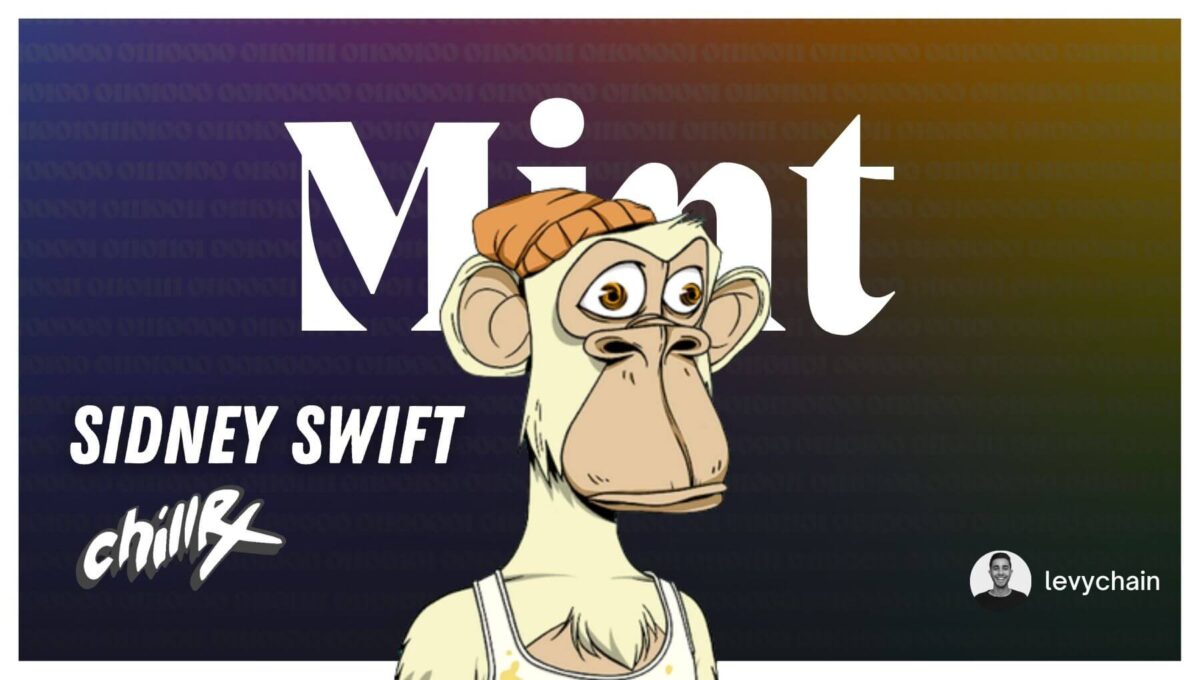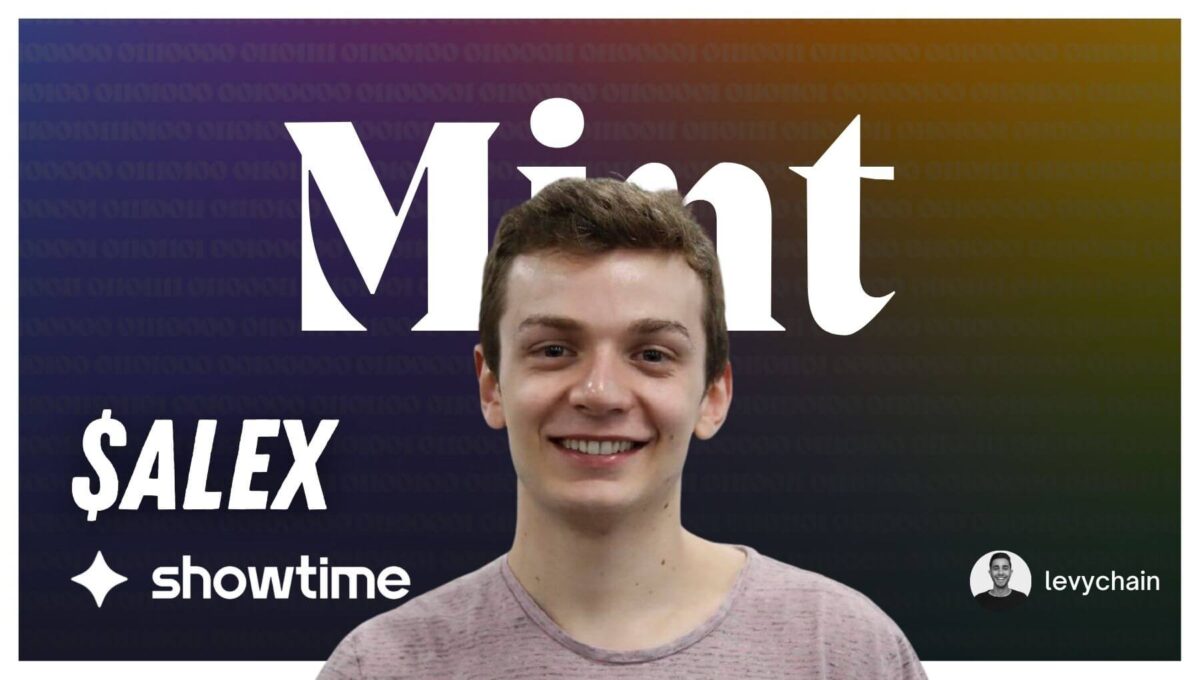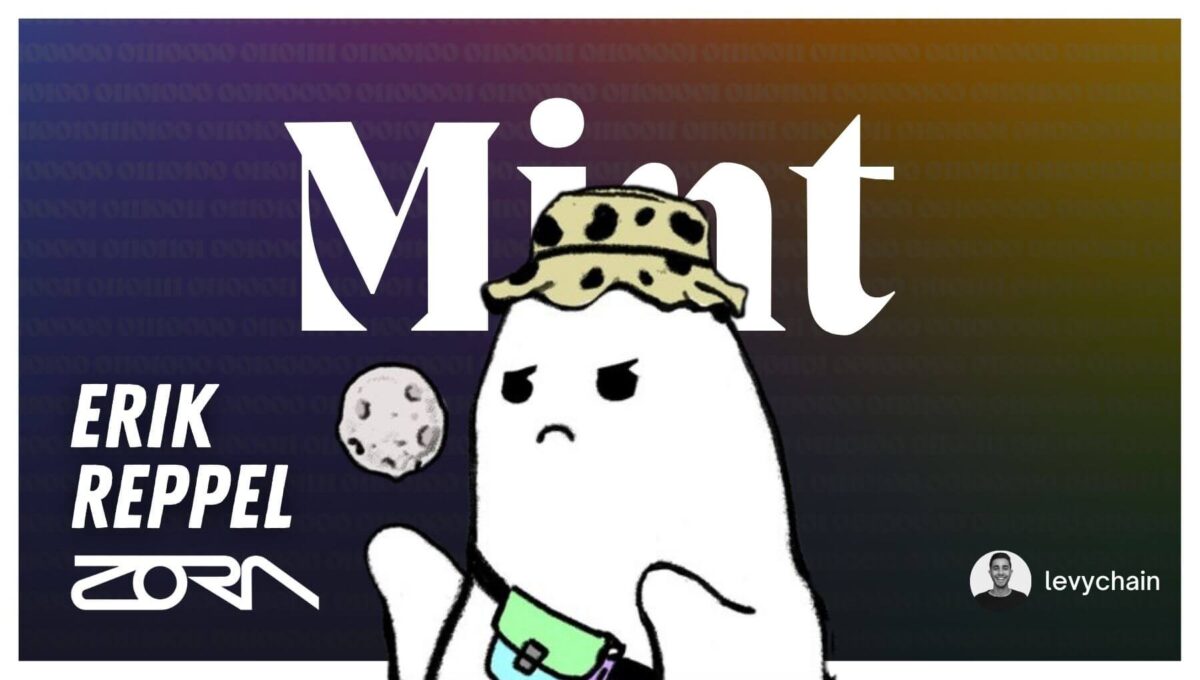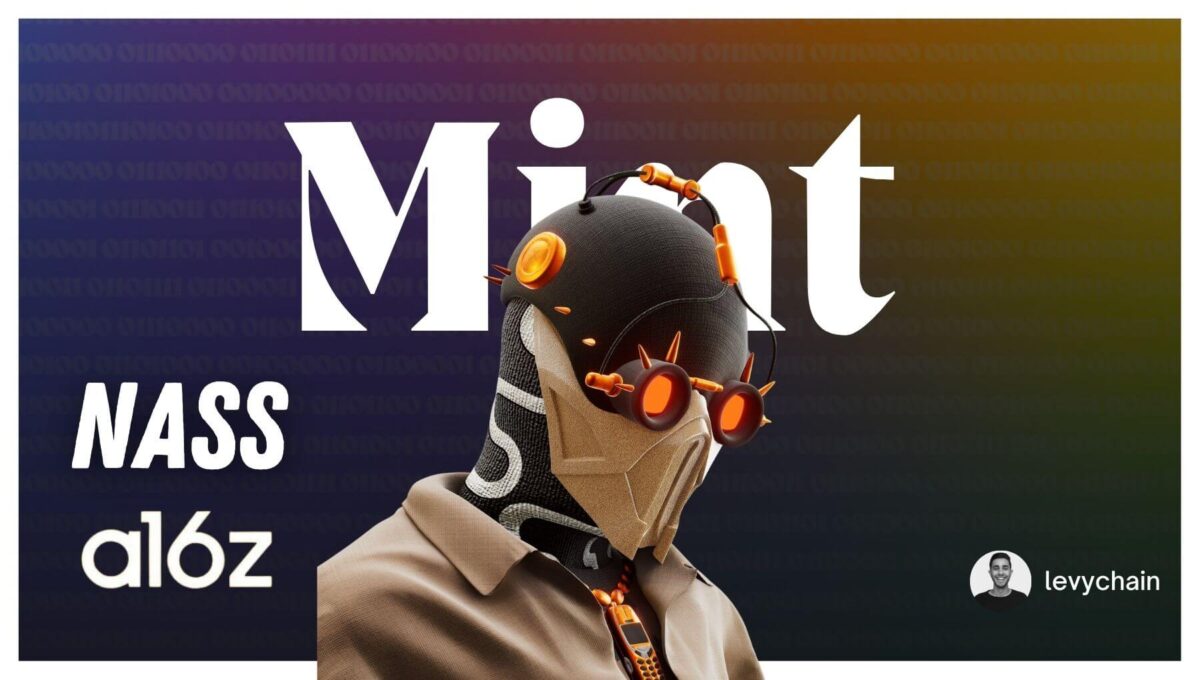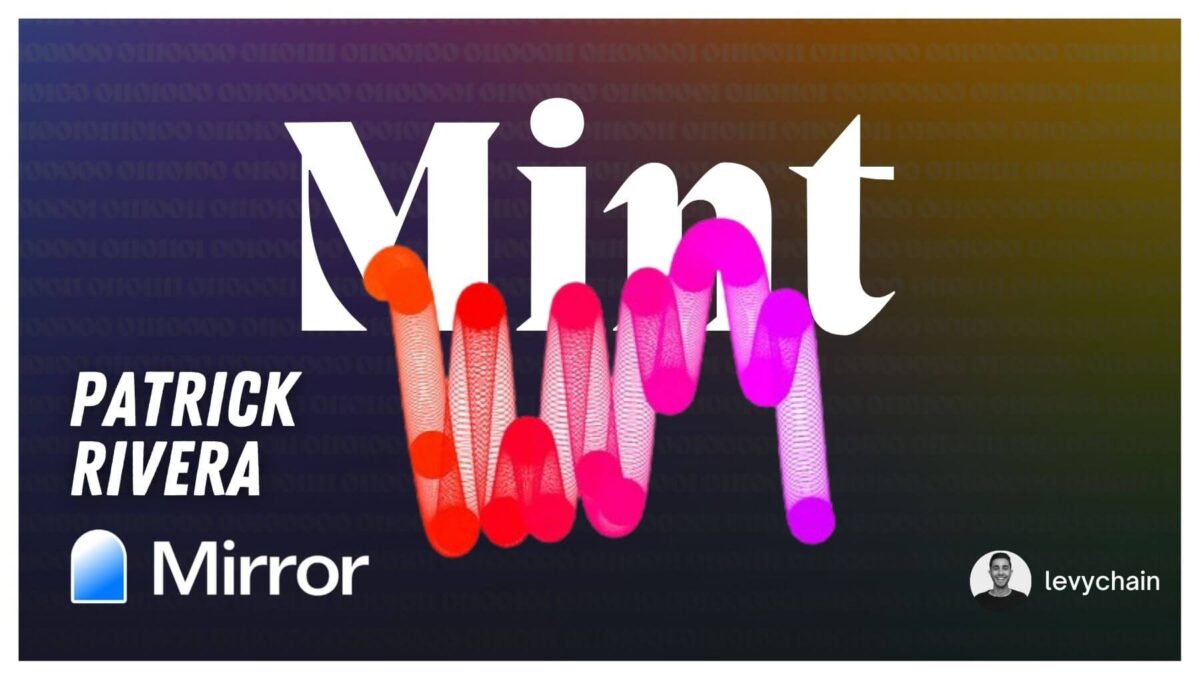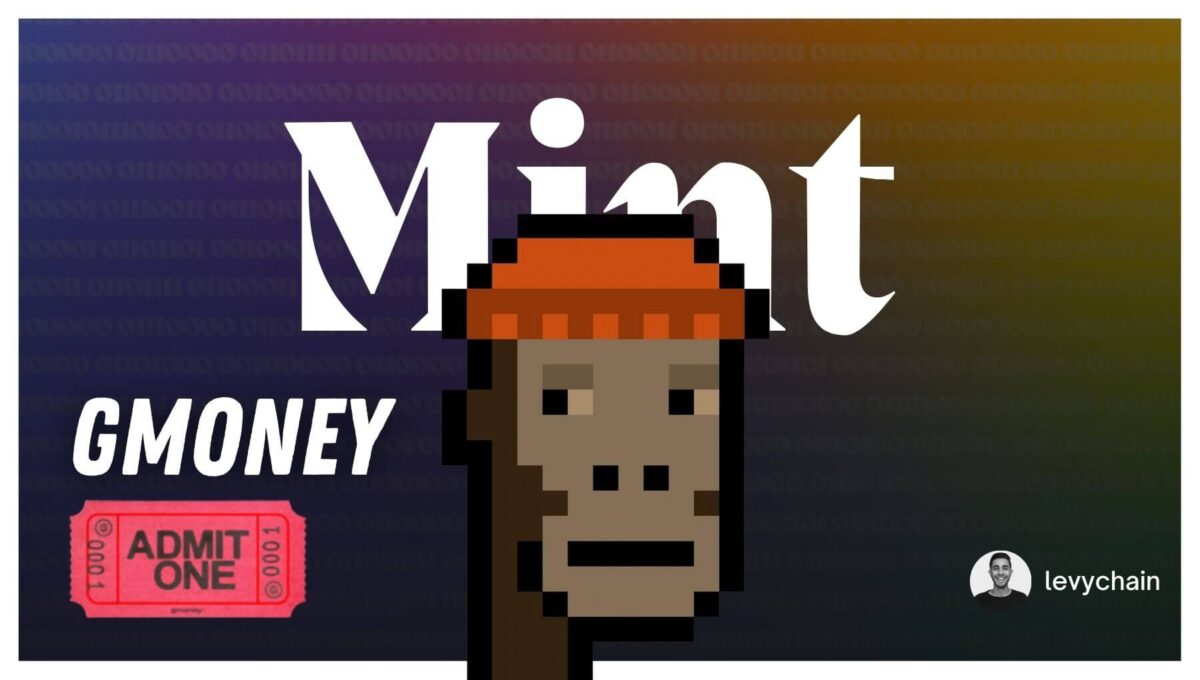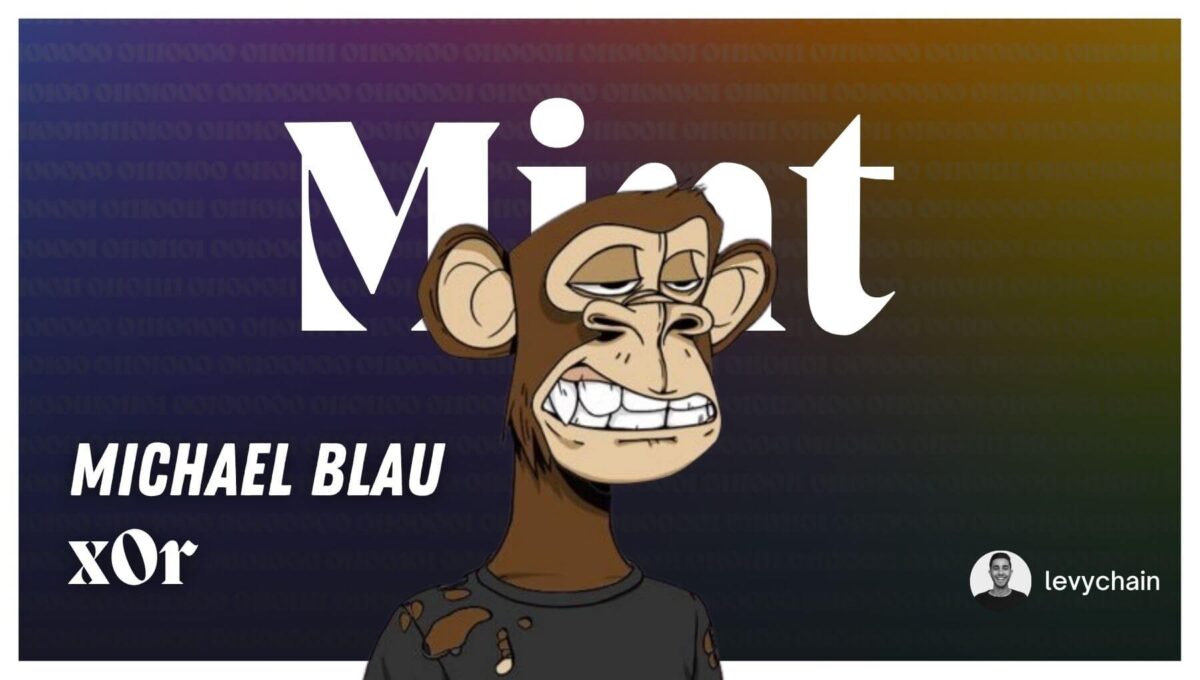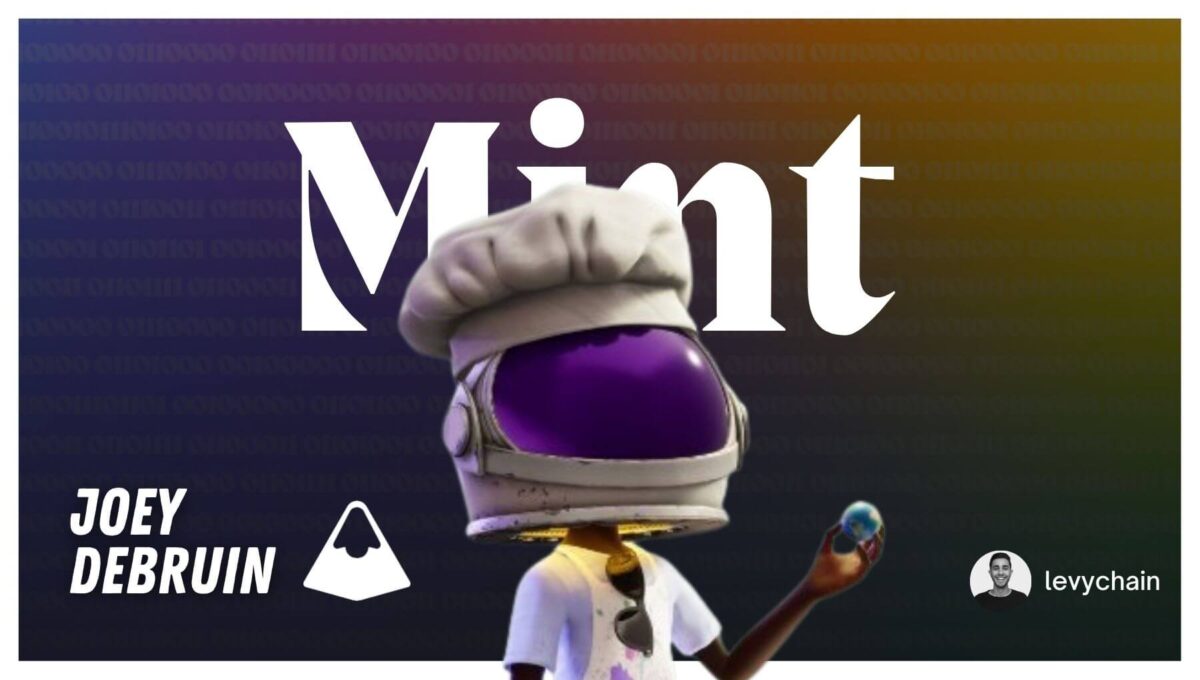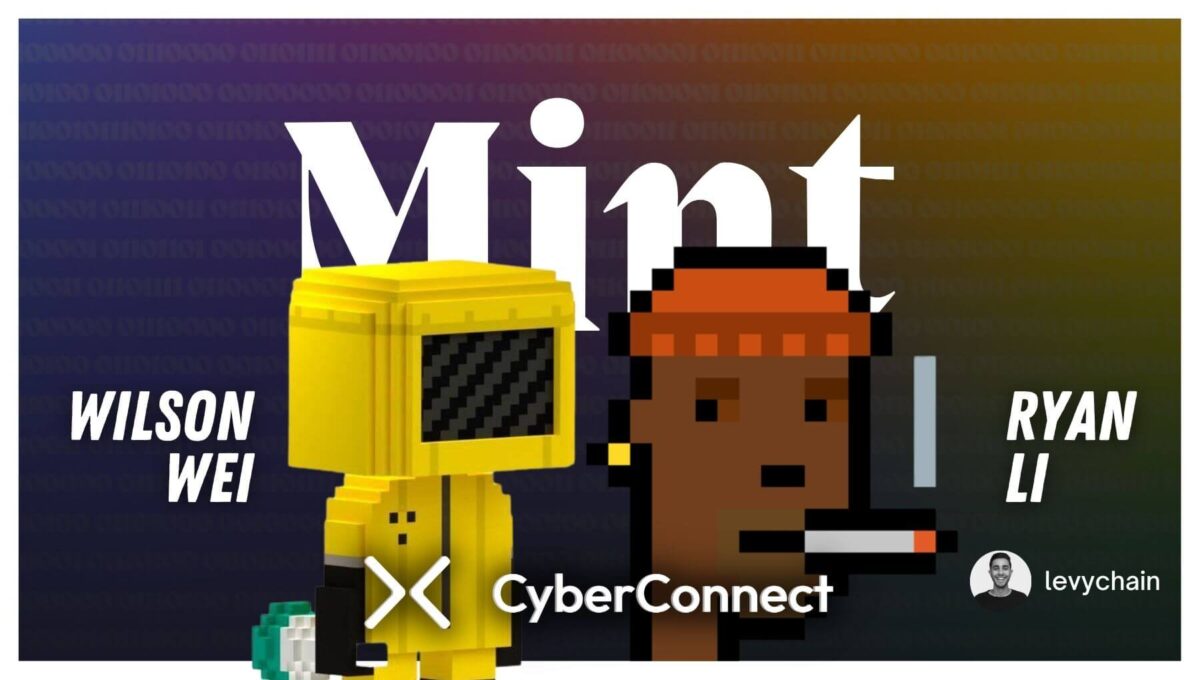Background
Mint Season 5 episode 17 welcomes Sidney Swift, an American entrepreneur and producer who cofounded intellectual property and creative development studio – Defi Entertainment. The studio develops virtual influencers, NFTs, songwriters, producers, campaigns and shows. More recently, he’s built the successful NFT Project Chill Pill – a meta star raking in hundreds of thousands of monthly listeners.
In this episode, we discuss:
- 00:07 – Intro
- 08:01 – Hustle Energy: What’s Your Cultural Background?
- 13:41 – Web2 Fans vs. Web3 Fans
- 16:36 – How To Find The First 100 Community Members
- 26:48 – The Great Traits of a Community Manager
- 40:19 – Web3 Music Movement
- 46:48 – Outro
I hope you enjoy our conversation.
Support season 5’s NFT sponsors
1. CyberConnect – https://cyberconnect.me/
2. Coinvise – https://coinvise.co
3. Mint Songs – https://www.mintsongs.com/
Interested in becoming an NFT sponsor? Get in touch here!
Sidney Swift, Welcome to mint. Thank you for being on. What’s going on?
Sidney Swift: Everything’s good. Thanks for having me.
Intro
I’m thrilled to have you a part of season five bigger than Ellen. As I tell everybody, I think a good place to start my friend is your way into crypto. Okay, I think it’s, everybody has an interesting story. How did you get your start into Crypto, and I guess in music in general?
Sidney Swift: So, start into crypto. Well, I’ll start with the music. Just like I always did that in high school. You know, it was like a side you know, come home from school, you know, hang with my friends. We make beats and rap and shit. I like started off as a rapper and then quickly realized that I was more of a behind the scenes kind of guy. So yeah, just I got some internships and originally from Florida. So got a bunch of internships and some studios out there and lucked up like Right place, right time, ended up interning at one of the studios called Hit Factory that’s like, where young money cash money was, like, kind of planted home base there. So, I got to kind of like, you know, watch, you know, as Drake got signed, Nicky. Wayne was there. And then yeah, just kind of, you know, worked my way through the grind of an internship, getting coffees, sweeping floors. And then one day, like, Jason Derulo was recording. And I was like, Fuck, this is my chance. So, like, I took all my beats and like, I put them onto the computer, and then ran out. And then the next day, the producers that were working with him called me and was like, yo, were those your beats? And I was like, yeah. I went into studio and then like, they like all pissed off because, like, you know, you’re not supposed to, like, you know, do that as an intern or whatever. But I was like, fuck, I’m not going to be, I’m not going to be waiting for another five years until, you know, my shit happened.
So, it just ended up like he loved some of the beats recorded to them. And then that was kind of like the initiation from going from intern to producer and then came out to LA. Quickly after and like, just worked with a bunch of artists, producers, songwriters, like you know, we did Beyonce, we did, Diplo Major Lazer, all that stuff. And just did kind of like the music rounds for a couple of years. And that was kind of also when I started dabbling into crypto This was probably like 2010 ish, 2011 And like, I just remember because like back then weed wasn’t legal. So, like it was like a lightning bolt when like you could buy weed online to the Silk Road. So, I was like oh shit like I’m gonna go you know buy some weed with some bitcoin on the Silk Road. So, I had like at one point I have probably like 1000s of Bitcoin, but I’m set like I’m just like buying grams off of the Silk Road with it. And then like in hindsight now like that shit I made those weed dealers incredibly wealthy but yeah, that was like my first start in crypto I remember having to like to go from my apartment. And like in order to get bitcoin you had to like to go to the Bitcoin ATM. Right? You’ll drive down the street, you’d go into like a Walgreens with had a Bitcoin ATM like you felt like a super fucking hacker. You know, like, crazy, and then you come back and hit the redeposit all that shit.
So, yeah, like, it was like, that’s kind of like my forte into it. And then and then just did the music thing for a while and then around 2000, I don’t know what to say like 2016, 2017 started to get more into the side of things. Because like, I was always into like the gorillas, I was always into, you know, like, quasi motor like idea of like digital artistry and like a anonymity whatever the word is, but yeah, it was like, heavy into that. And it was like a wide-open door at the time, like the gorillas, like, you know, slowed down, like they popped off in the early 2000s. But it was like a wide-open lane. So, we created this like virtual influencer in like 2016 called chill pill. We did a deal with Atlantic Records. We started dropping the project as like a web two artists, you know, like, but we were way too early. And like, nobody understood what we were doing. And like, I would walk into meetings and be like, we have an artist who can do a world tour in one night. Like, do you understand with like, the possibilities of that, like, it takes Beyonce, you know, two years to do a world tour and generate like what she does, like we could do it in one night and like, I was always like, into that, like, you know how big this could possibly be. But I think we were way too early and everybody’s kind of laughed me out the meetings in the beginning.
I mean, luckily Atlanta kind of like took a shot on us, but like, what ended up happening was because I was a producer and songwriter like I didn’t need to spend a lot of the money that we got for songs and beats and studio time. I already had all that. So, we spent all of it on like, you know, game developers and devs. And like it started experimenting in the metaverse back then and like at one point, we had like a motion capture rig where like I could like do studio sessions as the character in mo. cap and invite people in like artists who, it was like a bunch of shit, but like, we’re just having fun experimenting in the metaverse. And then yeah, when NF T started popping off, it was just like a no brainer until like, you know, start to pivot.
So, when you’re when you’re grabbing coffees for people and sweeping floors and doing a lot of the internship, like did you learn anything from that? Yeah, the OG sweeping floors. Yes. Yeah. Did you learn anything from that? Did you take anything away from that? It’s such an, I only ask because that’s the intro for a lot of people getting into the industry right, like entertainment, music, Hollywood, whatever.
Sidney Swift: Yeah, especially the entertainment industry. That’s different tech, right? Is tech, like, you know.
Code. Come on in. Yeah.
Sidney Swift: But like, like, yeah, in entertainment different. But I guess what it taught me was like, it kind of, like, it’s funny, the way that studios usually works back then was like, you know, you would hire 20 interns, right. And like, by week two, or three, there’d be three people left, you know, because not many people want to do bench work, you know, and not get paid for it. So, it kind of really quickly weeds out. Like, who has what it takes like to, like, withstand all the like, you know, long nights in the studio and like the, you know, I mean, the way artists work, I mean, sometimes I would get in the studio at 9pm. And we wouldn’t leave till 9am. You know, that’s just the way creativity works. So, like, you kind of have to be prepared for like, this, like, grinding mentality of like, you know, you never know when inspiration is gonna come, you want to be ready for it. And I think those early years kind of really, like, gets you ready. For like, that lifestyle. And it also like, I have so many people telling me like and asking me like, yo, you’re crazy. Like, why are you going into the studio for 12 hours a day, just sweeping, like not getting paid? Like, you went to school for this? Like, why are you doing it for free. And like, I always just like, you know, I always like try to think about, like, the mentality of like, I would rather be sweeping a floor in like this studio, like, you know, than, like, getting paid to do it at, you know, somewhere where I don’t want to be, you know, like, you know, so like, I would just grind bro and be like, during the day, I would work nine to five, during the night I would do the studio shit and like, it was just, you know, just me like, just kind of like proving to myself like that I had what it takes, like, I was gonna outwork everybody type shit, you know, and that’s really what I learned the most out of it.
Hustle Energy: What’s Your Cultural Background?
You know, like sabotaging that environment and popping up your beats on the screen that takes a lot of balls. Like, it takes a lot of, it takes a certain characteristic to do something like that. What’s your cultural background? Like where are your parents from? What’s your heritage, I only ask that because those traits, those like the hutzpah trait kind of like, I don’t know, it gives me different vibes. And I’m curious, what’s your cultural background?
Sidney Swift: I mean, like, I’m, you know, from America, like, my parents are from America as well. But like, my pops is Jewish, like, from like, the Russian descent side.
There it is.
Sidney Swift: Like, we had like a little mix, like, you know, mixed heritage and like, you know, I think like, really, where it came from was, like, my pops as an entrepreneur at heart and like, before, even like, music or anything like that used to, like, go to the office, like, and watch how he works. And like, he would grind from like, nine, you know, to nine, and like, you know, it was, I got to experience early on, like entrepreneurship and like, you know, the idea of like, you got to go for it, like when you have a chance, or else it could slip through the cracks and like, you’d never get that chance again, right? That’s always kind of been instilled in like, you know, my DNA is just like, I need to like I’m not gonna wait, you know, it’s just funny to bring that up, because it’s like, the biggest shifts in my life, like, and the moments that like take me from like, point A to point B and like, the next iteration of my story or whatever has always been, like the culmination of like, a moment in time when I have to like, go way outside of my comfort zone and just say like, do it like and you know, 90% of people probably would like not do this but like, I’m just gonna go for and it usually, if it doesn’t pay off for me, usually, like, in hindsight, it ends up like, oh, yeah, that’s the decision led to this to lead to that. And like, you know, so it always works out in the end like that.
Yeah. No, I love it. So, your, your vision 2016 way before NFTs existed to do this, like meta star, this virtual character that could travel the world in a day. And create this, like meta figure is very much fits in the context of NFTs, right? Which kind of transitions me into. When did you have that aha moment that this is the perfect medium to do what we envision back in 2016?
Sidney Swift: It’s funny, you say that I know. Brett, is that we’re doing an interview on Brett from launch house to, right? Like.
Yeah, he’s gonna be on.
Sidney Swift: It was at launch house. Like, it was, I had always been into NFTs and always into like, crypto, but like, it wasn’t until like, went to launch house. I’m like saw other builders, you know, like, it wasn’t, they weren’t hidden behind the screen. It was like, right in front of my face. Everybody was like, heavily invested in like, not the like, trading side of things. But like the like potential of the tech. And that’s what I had always been interested in. Right, coming from the entertainment world is like, the potential of what the underlying technology can do. So, like, it was really like launch house that like to be like 100%. Like I don’t even know if Britain knows this. But like, I got back from launch house and like, converted my entire company, from a web two company to a web three company.
Wow.
Sidney Swift: Like, ended up like literally, because they were like, we had like, like, probably like a 15, 20-person team. And, you know, some of them were into NFT. Some of them were against NF s and I had to like, train everybody. And like, it was just literally like, alright, like, stop what you’re doing. We’re going through like a month of training, I’m gonna, like walk you through why this is important. And like, yeah, we literally, like, converted from that like, and it was such a great decision. And it was, yeah, it really helps.
The team members that were against it, why were they against it? What didn’t they understand? What were they against? What were some of the confusions that sparked you to come and be like, yo, there’s an opportunity here.
Sidney Swift: So, the main, it’s funny, you say that. The main thing is the same confusion that most people have in, most fans having music, which is like, the environmental impact of crypto, like, and that’s first and foremost, like, everybody’s go to like, well, it’s really bad for the environment. Like and, and, you know, it took me like, laying out a whole, like, kind of like presentation.
Explaining logic trail.
Sidney Swift: Exactly, explaining like, yo, the banking system takes up 10 times more like than then crypto does right now. Like any transactions are doing like, it’s just the presentation and the lobbying and all that and the behind the scenes of like, you know, who benefits from what is, you know, skewed right now, but I also feel like it was me explaining to them, like, you know, like, you know, in the early days of the internet, like every, any tech, new technology, right? Like, it always starts with like innovation, and like, and then it, you know, falls into place with like, how that can adapt and scale over like to like, everyday users. So, I think like, right now we’re in that position where like it, everybody needs to be worrying, like mostly about innovating and scaling this, like, you know, then like, rather than just being like, well, we’re not going to touch it until it’s ready. Like, because then nobody’s building.
Web2 Fans vs. Web3 Fans
Right? You know, you bring up the concept, you bring up the concept of a fan. Okay. One of my questions for you is how do you think about the difference between a web two fan and a web three fan?
Sidney Swift: That’s a great question. I think the difference is, that’s a such a good question. I mean, it’s, I like to think about it in terms of like web, instead of web two, versus web three. I like to think of it in like incremental steps to get to web three. So, it’s like, you have a web two person and like that vertical is the person that like, is against NFTs, against crypto. They don’t want to hear about it. They think it’s a scam. They think it’s bad for the environment. Like don’t show that shit to me on my feed. Right? Then you have web 2.1, 2.2, 2.3, like that web 2.5 Yeah, the person that’s like sitting in web 2.5 is like, okay, I’m not against it. I’m not for it. I need to learn more about it like, but I don’t have the time to you know, take that step. So, like and then it’s just about educating from web 2.5 to like, you know, the initial first, you know, moment when you like, get a wallet. And finally find your ground and web three, past the point of like, you know, once you know, one purchase, and then you’re done, like, to really cultivate that fan, like in the web three world, but I think it’s more about like learning the demographic of which vertical you’re dealing with, at the time, and then giving them what they need in order to eventually get to the web three mentality, right? Because people in web two they like just like the employees that I had to like, you know, explain like this. Step one was like, this is, you need to learn more, let me explain to you this stuff. And then they got a little more open minded. And then it was like, okay, let me walk you through some of the lore and like, some projects you like, and some projects I like, why don’t you go find some interesting product like, and like it was slowly weaving into them into it. But like, so I think the only difference between the two is education, is, 1000% education like and then as a business, once you identify the type of fan that you’re dealing with, it goes back to the fundamentals of building a business, which is like, customer satisfaction. So, whatever your product is, whether it’s music, whether it’s, you know, a protocol, whether it’s a Dao, whatever it is, like, are your customer satisfied, like, so, yeah, I think a whole thing right now is education. Right? Like.
How To Find The First 100 Community Members
Yeah, so, part of building that customer base and went through, we call it building a community, right. And it’s incredibly hard to build a community. But if it’s done correctly, it’s incredibly powerful. And the hardest part for many creators is getting started. There’s a lot of buzzwords that kind of get them stuck in the rabbit hole, from understanding how everything kind of works together. But when it comes to actually building the community, it’s a whole another mountain to climb. Right? How do I find my first 100 People that align with my vision? How can I bring them into discord, mutually align them with incentives, and get this entire ship rocking? How do you find your first 100 people to join your community? How did you do it? And what are some tips you can give to others?
Sidney Swift: Slow and steady.
Okay.
Sidney Swift: Slow and steady for the first 100. Like, I think scaling, you know, I mean, if you if you break it down, like from a numbers game, like going from one to two, and going from, you know, 100 to 1000 is, from a scale scalability wise, it’s like the same kind of leap, you know, without 1000, like, you’re doubling your customer, or whatever, like, you know, so like, you’re growing it at an exponential rate. So, like, you want to take the same kind of like thought, every, like, every time you’re like, I would say 10 axing your customer base. So going from like that first one person, like, think about, like, how much it takes to like, really convinced one person, and then it’s just tweaking and thinking like, okay, so how do I scale that a little bit to like, move to 100 people, right, and then taking the time to tweak their approach. And once you have that, 100 people, it’s scaling to 1000. But like, in the beginning, it’s about persistence, and like, pleasant persistence, and like, you know, like, just making people feel emotions that are positive, right? That’s all people ever want is just to feel good, like, and they don’t want to feel bad. So, it’s like finding like those first 100 people and finding like, what you how do you make people feel good, the best? What can you provide, like for them? And then just doubling down on like that, and like spending, you know, the majority of your existence, like, making sure that, that your community feels good and is excited, and is happy and like, you know, it’s funny, because, like, I think like, going through a couple of drops on our own and learning like, about community building through the whole process. I think that something that a lot of people forget, because it’s easy to get wrapped up in the space and like, what the, like, current trends are for the moment.
But like, one of my big beliefs right now is, you know, I have a shirt that says expectations minus reality equals happiness. Right? And like, I kind of like that’s like my mantra going into like, communities that I’m joining, you know, NFT projects that I believe in, like everything like, because at the end of the day, if I have no expectations, and then you, and then you beat them, it’s like, I’m happy as a customer. Or, again, if you don’t, then, you know, I’m, I’m upset, or if expectations are different than what I assumed they would be, you know, so it’s like, finding that way to, like, cultivate customers or community or whatever you want to call it, cultivate that community to, like, not have expectations, but just be there for the cause and the mission, and the people, you know, and then, like, truly be there for the community. Because then when you start to sprinkle in utility, you sort of sprinkle in expectations. Like, it’s like, oh my god, I’m so surprised. I didn’t know they could pull that shit off. You know, and that and now that’s how you start to grow and develop, and I think that that’s the most exciting, like, one of the most exciting parts about like, the spec the tight like, I know, it sucks because like we’re in like a downtrend. And like the market is crazy right now, obviously, but it’s really interesting that like, how much recalibration is happening for the strategy of collections and like, not just collections of NFTs but like, it’s like all companies are just re strategizing on like, the promises they’re delivering on like, you know, the types of fans and communities they want to like, you know, associate with or the types of, of like, you know, activations that they’re doing and like, I think that like, it’s a recalibration is really healthy, because we got to a point where it’s just like, you know, every other project was like building a metaverse. You know, like, eventually, you know, and like, that’s like a huge. That’s huge.
That’s so funny. You bring that up, because the default thing that many projects do once, they build their 10k Collective, is they just assume everybody just wants a Metaverse next and that’s where their energy goes towards. And it always struck me as like the second meta came out with their Metaverse rebrand, right? Everybody kind of flipped it like, this is the future like, this is what we’re building towards. This is what we’re doing. This is where we’re going. Everybody’s gonna want that. And it like, it makes me think like, does everybody want a metaverse? You know, how many meta verses do we need? Like, how many worlds do we need to take our PFP project through? I don’t play games like I may not be the right user. I don’t spend time through these virtual worlds. I saw some of the snippets from the board club game as well that were trending on crypto Twitter. And I don’t know, I don’t see myself like spending an hour, two hours, three hours a day just like doing W A S D and just like walking around this metaverse. Like just chilling. You know what I mean? I don’t see it. I don’t see it.
Sidney Swift: I agree. I agree. I think it’s like going back to like, what is your community want? What is your customer? Like, it’s interesting, because like, when you do say things like, you know, we’re building a Metaverse, it’s like, it’s really interesting. Like to see the difference in like, are the community members there? Because they want to play the metaverse game, are they there, because they think that if you build a Metaverse, your NFT will go up in value, and then. So, it’s like, by simply stating that, like, you kind of attract, you’re attracting the kind of that type of customer that has expectations for what that is going to do for your collection. So, it’s like you like for me, like finding the right, finding the right customer bases, you know, and like, and letting the product and I hate to talk about it. And like web two terms like it’s like, because I always go back and forth with my marketing director too, I like, you know, do we say it’s like a community manager? Or do we say it’s like a customer experience, you know, director like, what, there’s no difference, you know, except like a company manager does social media, but everything’s merging right now. So, like, at the end of the day, it’s just like, what do your customers want pre-mint? What do your customers want post-mint? And if you can align those two, where you’re finding the right customers, pre mint, and then delivering post-mint, you’re knocking out of the park, you know, and like, you know, if those don’t align, then you find yourself in like a really interesting.
The strategies, the funnels, the under promise over deliver these things that have won the hearts of people in web two, is just rebranded with new keywords in web three. That’s just, it’s just what it is. People still want to feel a part about something, you feel a part of something that hasn’t changed, web three hasn’t changed, web three maybe solidified that even more with better incentives, right? The product is the NFT, the product, we are the product, right? But we’re building collectively amongst each other in this, through this new medium, you know, so I really, I really resonate with a lot what you are saying, it’s funny you bring up the metaverse stuff because I think everybody is just hoping that meta acquires them for something because they’re building a Metaverse and they’re hoping that I don’t know what the strategy is honestly, I don’t know what the strategy is. But to assume that everybody wants to build it like everybody wants a Metaverse because we’ve been living in the metaverse. We’ve been living in the metaverse since 2008. Since Instagram was alive, Twitter, Tik Tok, we live online, right? Meta just rebranded to meta so that they can sell more Oculus, right? Like that’s the whole angle over here. And I don’t know, I’m going on a rant right now, I’m gonna shut up.
Sidney Swift: Well, I agree with you 1,000%. Like the minute like, I think people like I think people forget, like the macro term of Metaverse is just like, it’s the internet with web three technology. You know, so it’s interoperable. Like that said, it’s like an interoperable internet like, and like, you know, so like, on the grand scheme of things like, you know, Twitter is the metaverse right now, you know, like.
100%.
Sidney Swift: Discord is the metaverse like.
100%.
Sidney Swift: So, like, I think like that’s why goblins nailed it. Man. Goblins fucking nailed it, because like, they realized that they don’t need to build a Metaverse, it already exists. So how do we just give that experience of a Metaverse across all of our Metaverse platforms that we’re already in, like through discord through Twitter, through the smart contract, like, wherever you turn, you’re still in the world of that brand. You know, so you’re still in their Metaverse, which is a really meta thing to say, like, if you scale that out, but like that’s, kind of like, where I feel like, you know, we’re about to start shifting to is like, you know, the realization that like, yo, if that metaphor is already exists, we don’t need to build one, we can build a better iteration of it, but like, you should do it, what your customers are already living, and not just like, you know, yeah, so that’s how.
The Great Traits of a Community Manager
I hear you, bro, I hear you, we’re on the same page, you know, you talked about like marketing directors, community managers, my next question to you is what goes into, I guess? Like, what are the traits, for example of a great community manager? What does that entail?
Sidney Swift: So much.
Give it to me in like a five-point breakdown, three to five-point breakdown.
Sidney Swift: Like a good community manager is an organizer. Like, I think in terms of like, the people organizer. Like it has the traits of like, a founder, or a politician. And I don’t mean like the bad parts of the politician, but I mean, like, the parts of a politician where like, you can get in front of people and say, your mission and people, like, want to rally behind it. And I think a community manager, you know, has those traits of like leadership in the form of like, extroverted leadership. And then I think, like, a good community, I mean, shit, like, now I’m talking it out loud, like, a good community founder is like, it’s a good community manager is a good founder. You know, and they think that like, I think, yeah, like, you know, rallying people behind, like a cause. What else I think like.
Like, what are some of like, the soft skills, for example, because right now in crypto, the two most in demand types of people are developers, and community managers, right, developers, that’s not my wheelhouse. I don’t know what goes into finding a great developer. But I feel like I have a good sense of what entails, what traits kind of like comprise a strong community manager, but you’re on a community, you guys have hundreds of 1000s of people listening to the chill pill music that you’ve kind of created this 9999 PFP community around, right. And it’s no easy feat. Like, those are 1000s of people that have incentives aligned with the success of what you build Sidney and on top of that, everybody that listens to that on Spotify, and Apple Music, etc. Also align with that. So, it’s less maybe about having what goes into a great discord moderator, right. But it’s also kind of like managing the entire brand as a whole, because the people who listen on Spotify are also part of your community. Right? And probably the people who hold also hold your collectibles. also listen to the music, but probably not everybody who listens to the music hold the collectible. So, there’s an interesting like, mix over here of sure. You don’t want to get too lost in the sauce of what happens in discord because there’s more to this community beyond a few servers, right? Yeah. So, I guess like, because you’ve built companies, you have people working for you, you started projects, you had this vision for this meta character, you know, this meta star. And yeah, I guess like bringing it all together. I mean, it’s a founder’s point of view. So maybe you can take it from the point of what goes into a great founder, I guess in web three.
Sidney Swift: Yeah, exactly. I mean, like, you nailed it, like, you know, the community does not just live on Discord like, and, you know, like going back to the old point, like, you know, the metaverse is wherever your customer is, at that time, you know, digitally. So, a good community manager like is somebody who can identify what is reacting, what the community is reacting to, and give the community the tools to build off of what they’re reacting to the most. And then identifying the leaders within the community, and their superpowers. And then in enabling them or incentivizing them to rally their subsection and their superpowers of the community, you know, so like, a good example is like, you know, we have a music community manager, Joe, who’s incredible. Joe was a chill pill fan. Before we even were at NFT. We’re in an NFT project. He was like, you know, always commenting on our stuff. He was doing what a social media manager should be doing on the on the daily, right, like commenting on stuff, responding, retweeting all that. And then like, when we went to, we went to a studio called the Record Plant the month before we mint it, and did like a lot because we were like, how are we going to doc ourselves, like, how are people going to understand like that, like this NFT equals music. So, like, we kind of like, planted our, you know, our project in a major music studio and said, like, yo, everybody come through, like, this is where our home bases and like, early on. And like one of the Twitter spaces, we were talking about, you know, music and all this, you know, what the project has means to us and everything. And Joe started talking about how excited he was and how, like, he’s been following this and whatever. And somehow, I don’t exactly remember what the lead to this, but like, it ended up the conversation going to like, yo, why don’t you fly out to the studio, and like, Come hang out with us, because you’ve just been so like, down and like a such a big believer in this project from the jump.
So, he was like, Yeah, let’s go like, if you guys, I have a couch to stay on. Like, let us let me know, and I’ll come flat. So, he flew out and ended up like, you know, being there during like the sellout, hanging out with us, like, you know, ingraining himself into the community. And then like, you know, post-mint, you know, I saw that, like, the majority of the community was like craving more music activations, more listening sessions, more of that, you know, that vertical. And it just like, it just like made sense, like that Joe was already doing that he already believed in the project, he loved it. So, like, we were like, Joe, Joe, do you want to run, like the music community side of things, and he like, he’s been killing it. He hosts community songwriting sessions on Discord and Twitter, where we’ll have like, 1000 people, like, come in and write one song together, you know, and he runs those events, he like, runs the listening sessions, the beat battles, it’s like, we have like, just so many music, like focused activations, and he runs them all. And, and then what, and then he’s so good at like, also, like he’ll recognize somebody’s, like, a really dope producer, out of the crew, and then he’ll be like, yo, like, why don’t I, you know, why don’t I do, like, let you handle the next couple, you know, music production sessions, you know, and starts to empower the people that like him are, like, involved in the community from the jump and, like, do it naturally. And I think that’s the best community managers, are the people that are excited about the project, believe in the project, 1,000% they live, eat and breathe community and the project’s mission.
And then they’re able to organize people and give them, you know, the tool sets that they need to take the brand and run with it. And like, you know, I mean, that’s the beautiful part about when we’re building it all together. So, like, you know, like, you know, some somebody can submit to us a song, or an idea for a song. And then we can go to the other producers and be like, yo, like, do you guys want to work on this song, and then they send it back to us. And then we send it to our artists and then the artists make some stuff with it. So, it’s just like, you know, interactivity within the community and like that one person driving that needs to be the community manager like, and it need to be so like I said, live, eat breathe, community. It’s like an incredible personality. trait to have right is like being that kind of always on person.
Yeah, I think, Sidney I think I completely agree with you. I have a different take. I think the best community managers don’t manage communities. They empower others to create sub communities. And within that, people congregate independently and have a great example. Okay? Great example is Lady Gaga is probably one of the best community managers ever alive. Why? Because look at how many people created sub communities just on Lady Gaga, I’m looking on Facebook groups for everybody that’s listening on audio only, right? But you have 51,000 members, 21,000 members, people posting 10 plus things a day. They organize independently. And this is without incentives. Right? This is without align incentives to see the success of Lady Gaga, they’re just doing it because they love Lady Gaga, because they aligned with her why, they aligned with her purpose. And through that they create sub communities, and they find other people that align with their why and their purpose. I think the best community managers don’t actually manage communities. They empower others to create sub communities around their purpose. I think that’s what it comes down to. Because this right here, this is an army. This is a fucking army that I’m scrolling through right now, right? This is something that not one individual person can create on their own, can manage Lady Gaga does not manage all these people, it has to come from within the person. Right? And it has to be empowered through independence.
Sidney Swift: 1,000%. Like, especially if you want to community to scale, right? Because, like, you need to figure out the ways in which like, I mean, everybody’s different. And like you nailed it, like sub communities inside of the generalized brand, like you know, going back to like Lady Gaga or even Nike, you know, like, there are runners, there are basketball player like they’re athletes within, you need you need people that are excited about those sub-genres, you know, within it. Yeah. 1000s.
You know, it comes also Flexi from a technical and feature point of view, sub communities can form based off rarity traits, right? Let’s talk about board ape for a second. Okay, so you have the golden apes, you have the board like the one type of facial expression ape, you have all these different variations and all of them kind of congregate, congregate together. For punks. You have the purple hat groups, you have the 3d eyes, right? The three lenses’ glasses, right, you have all these sub type of features that people can independently form a collective around without there needing to be a community manager, right? They find alignment within the features and the rarity traits that kind of bind them together. And they have aligned incentives that take them all the way to the top or to the bottom. You know, and I think that’s the most interesting part about a bear market too, because the bear market, it destroys all the noise. It weaves in quality over quantity, right. And with that, when you’re going through cycles, and you’re going through the highs are highs, the highs are fucking high. You’re celebrating what but when the lows, they can get pretty low. And that’s when you get really tight. Like that’s when the bond it solidifies. Right. And I remember back in season one of the podcasts, I had Dave from Play coin, okay, a social token project. Okay, it has more liquidity, it fluctuates, I think more than the general typical NFT. And he was saying, he’s like, my community got the strongest in a bear market. And it weaved out all the bullshitters, who were just here to flip and fuck around with our token. And we really, we stood and stuck with our purpose during the bear market. And these low prices allowed us to solidify that energy internally, right? And what I’m trying to say is that bear markets are beautiful, bear markets are good. They’re great for communities. You know, that’s the takeaway from this monologue. And I just gave.
Sidney Swift: I agree, 1,000% man, like, don’t get me wrong, it’s sucks to get wrecked. And like, I’m not, I’m not endorsing. I know you’re not either endorsing like. But I do agree with you in the sense that like you need consolidation, or else like there’s no world in which we live, like, where Crypto consistently rises forever, and there’s never a red day or there’s never like, you need the ying yang in order to, in order to even make there be a good and a bad right. So like, I think that like what, like if you’re presenting like the glass half full version of this bear market, it’s exactly what you said, which is you really get to see who’s here for the reasons other than making a quick buck flipping, you know, flipping NFTs or in and out like you really get to see who’s down for the mission behind everything you know, and I mean that sediment traves like through web two and web three, right is like you need, even when you’re building a company like you want the company culture is everything. And it’s like now with the NFTs. And on web three, it’s like the community culture is everything. So, it’s really just scaled that whole idea. It’s exciting.
Web3 Music Movement
Yeah, another thing I want to talk to you about is very much up your alley, and very much on the theme of chill pill is where music meets web three, okay. In the last four or five, six months, things have gone out of control. We’re seeing a wave of creativity of music artists just entering into the space, finding their creative liberation, finding new collectors, building true fans, etc. With aligned incentives. What are your thoughts on this entire movement? Like, what’s your thesis on entire like music NFT movement, right, and you can take this also, and I’d love for you to take it from your lessons learned working in web two music, and how that’s kind of, like, led you on the path to web three music as well, you know, I’d be curious to hear different takes on that.
Sidney Swift: Yeah, I mean, like, from my experience until you hit a certain threshold in web two world of music, or any web two world of entertainment, like, it is really hard to make a living, you know, I mean, just from personal experience, like, you know, I will make, you know, 10,000 beats, you know, or I’ll spend that 10,000 hours making beats, and, you know, a successful producer or songwriter maybe gets, you know, a couple cuts a year, if that, you know, the 1% of the 1% are getting, you know, hitting every album, but like, the majority of successful producers and songwriters in the space, like, you know, they get a cut here, they get it on this album but like, it’s no more than five, you know, cuts, Tennant cuts. So, like, if that’s the majority of what drives the ecosystem, like the other 9999 hours spent making music is just there. Like just sitting there, like, you know, and like you’re not, it’s really, really hard to monetize that, you know, and that’s talking about the 1% of people that actually do get the cuts, like the 99% of people who like are trying to get to that 1% is like so the, the grind for any kind of creative industry is incredibly difficult to, like, make a living out of, and so like, I think web three changes that model 1,000% And it like gives all the power back to the creative to, you know, to make things of value for their audience immediately. And monetize the entire experience rather than just like, you know, the end product of like a song going to market, you know, like something that we’re working on is a plugin, an audio plug in, which is like, you know, when you’re making music, you use plugins to like, either do sounds or make reverbs.
so we’re making one and it’s going to be like the first you know, community made plugin by the community for the community, we’re going to, we’re going to launch that probably in the next like, couple months or probably sooner than later and then and the idea behind it is like, you know, we want one to give our community access to the code base for the plugin, so they can build on top of it and like talk about you know, sub communities like you know, if you’re into music and you’re into coding, you get to play around with this you know, this plug in that we like kind of started for the community and build on top of it, add new reverb, add new delays, add new sims like and the big vision for it is token gated, so that there’s, token gated for the coders and then create like a some kind of internal staking mechanism where like, you can earn crypto as you’re using the plugin and creating the music.
So, like getting paid for the 10,000 hours that like you know, you’re working, you’re actually generating income from it. And, like so like things like that were like crypto, empower and web three empower, like creatives to have opportunities that they like, normally wouldn’t have had with the old model, you know, and the old systems at play, you know, even just artists just being able to, like, you know, sell an NFT for one Eth. You know, like, what I mean, not now but like previously, like, you know, before the bear, like when Eth was at 4k, one Eth equal the same amount as 1 million streams. And that’s if you own 100% of the song. And the majority of songs have co writers and co producers work together. So, like, you know, if you have a million streams, and you have a band of four, you’re only making $1,000 per stream. And then that’s not even counting, like, you know, management fees, and, like, you know, label fees and all that shit. So, like, there is not a lot of money in streaming. So like, they’re like, I think like, the interesting part about going direct to consumer is that like, you can begin to, web three artists can begin to target the web three vertical and monetize immediately, instead of having to wait for their song to hit a million streams and then Spotify to pay the label and then the label to pay the artists nine months later, you know, like, that’s an unrealistic funnel. So, I think that currently, it’s an incredible opportunity to get into for artists and dude, like, I mean, shit over the next couple of years. It’s even, it’s gonna get even crazier. Like, I think, very quickly, artists are going to realize that they that they don’t need these labels, you know, especially labels that don’t adapt to this new tech and like, include it and like, help them use it, you know? So yeah, yeah, it’s exciting.
Outro
I think that’s a mic drop moment right there, before I let you go, man, where can we find you? Where can we find more of the project? Show it away.
Sidney Swift: at Sidney Swift is my Twitter. The project is chill pill or it’s at I am Joe pill. I think it’s, yeah, I am chill pill on Twitter. Yeah, that’s like, that’s where we live the most. You know, from there, you can kind of explore all of the different shit we got going on.
Sick. Amazing, dude. Thank you so much, we’ll have to do this again soon.
Sidney Swift: Yeah, dude, I’m excited. I’ll see you NFT NYC. Right?
I’ll see you. Yes, sir.
Sidney Swift: Let’s do it.

